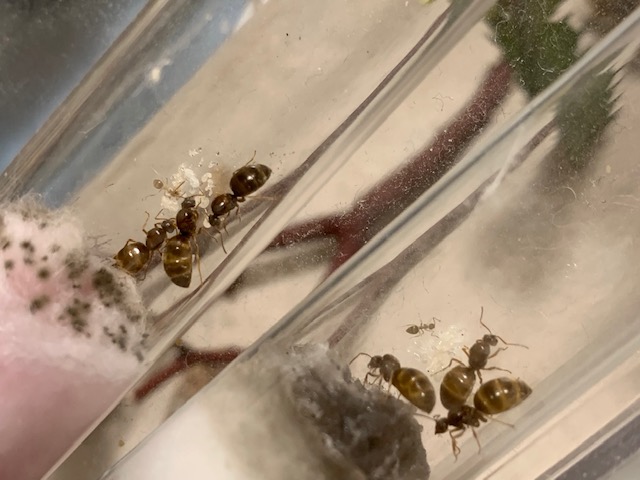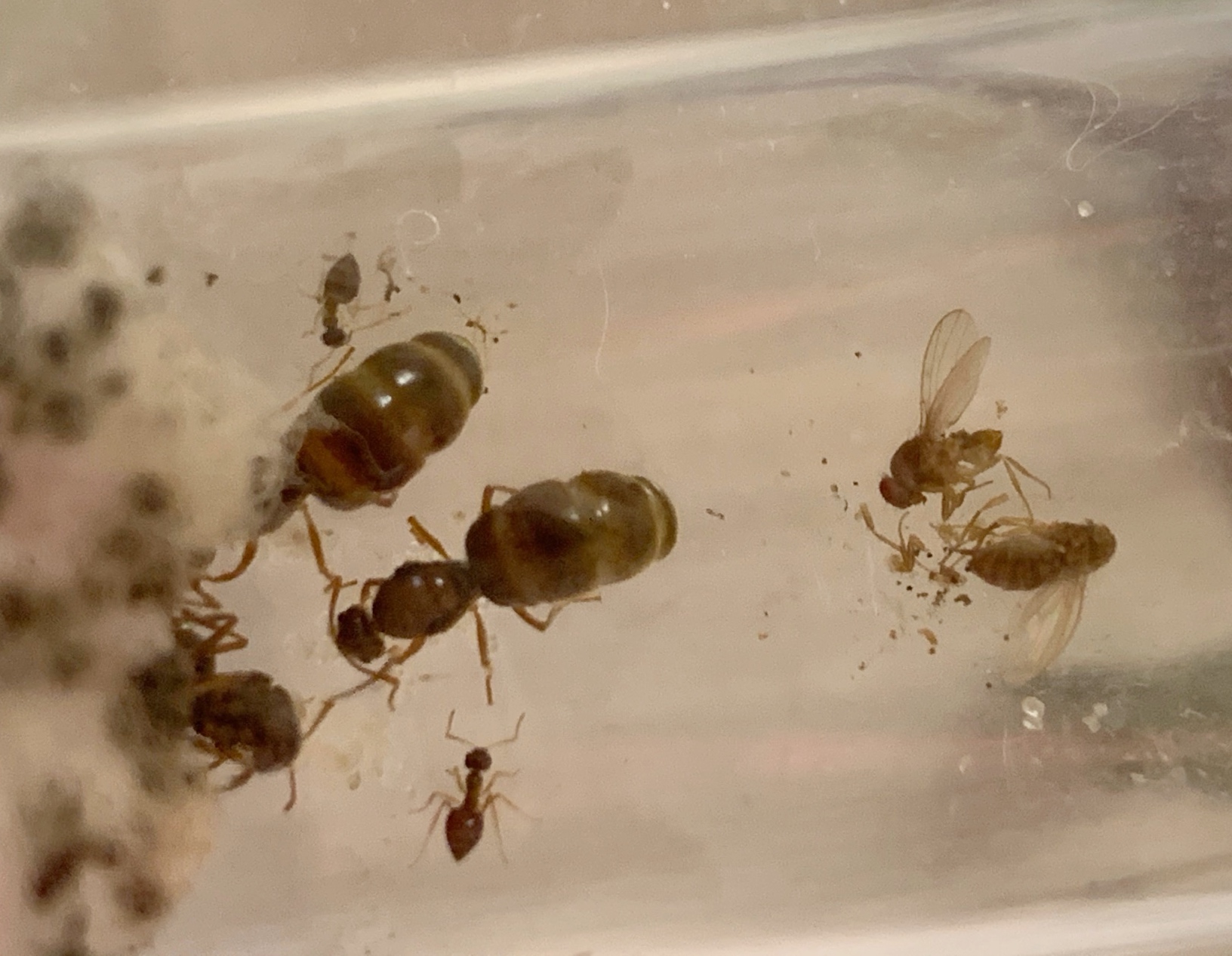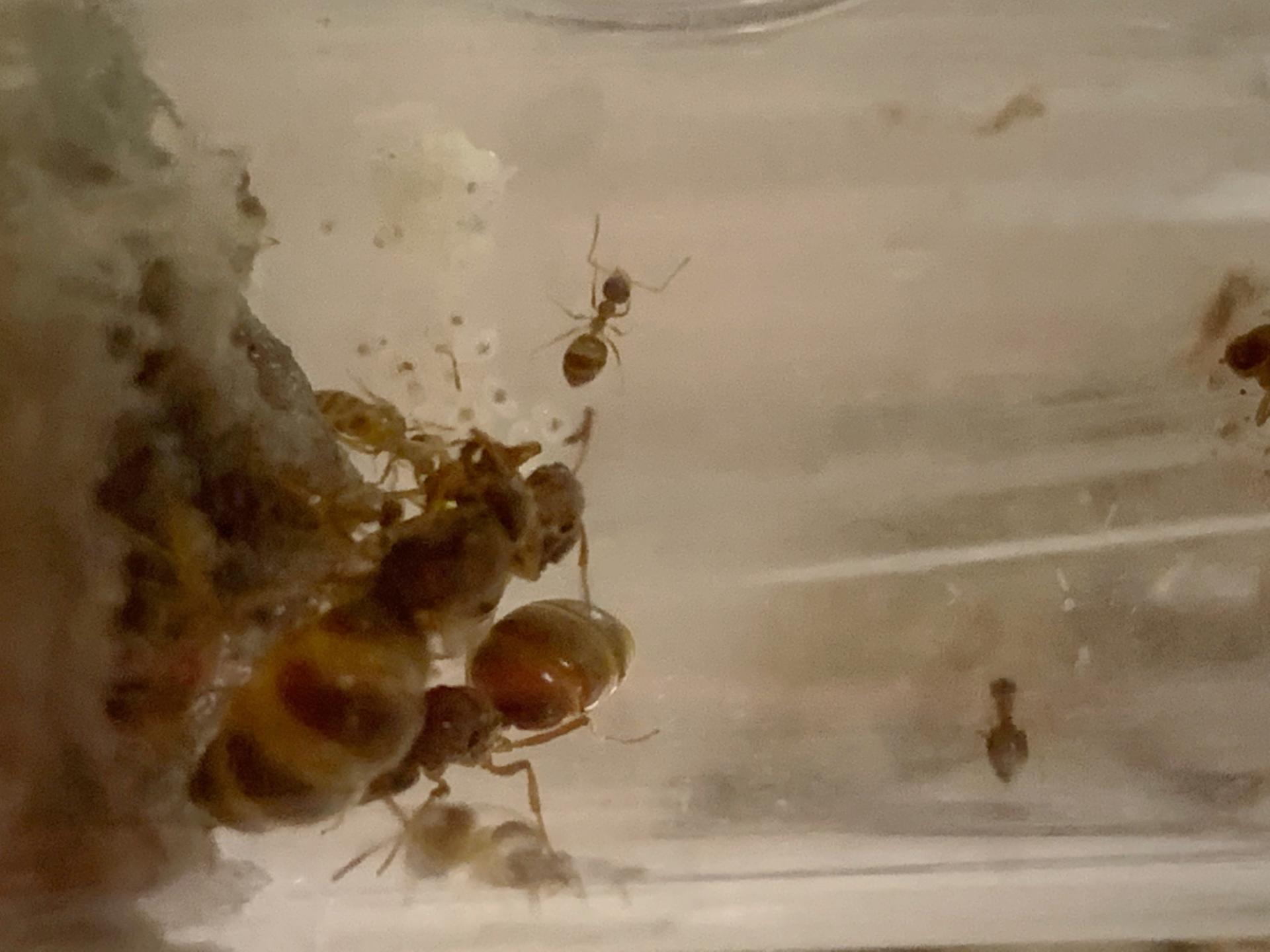- Formiculture.com
- Forums
- Gallery
- Members
- Member Map
- Chat

OhNoNotAgain's Prenolepis (videos), Liometopum (video), Myrmecocystus mexicanus
Started By
OhNoNotAgain
, Feb 9 2020 2:05 PM
148 replies to this topic
#21
 Offline
-
Posted May 29 2020 - 12:07 PM
Offline
-
Posted May 29 2020 - 12:07 PM
They probably will not move on their own.
"The ants are a people not strong, yet they prepare their meat in the summer." Prov. 30:25
Keep ordinary ants in extraordinary ways.
Keep ordinary ants in extraordinary ways.
#22
 Offline
-
Posted June 12 2020 - 4:06 AM
Offline
-
Posted June 12 2020 - 4:06 AM
Any update?
Sent from my SM-G975U using Tapatalk
Sent from my SM-G975U using Tapatalk
#23
 Offline
-
Posted June 12 2020 - 9:36 AM
Offline
-
Posted June 12 2020 - 9:36 AM
Are they dead yet?
#24
 Offline
-
Posted June 12 2020 - 11:24 AM
Offline
-
Posted June 12 2020 - 11:24 AM
Think they're still alive
- MinigunL5 likes this
I love Camponotus!
Old Shop: https://www.formicul...-stallbay-area/
Current Shop: https://www.formicul...17962-ant-dump/
#25
 Offline
-
Posted June 12 2020 - 9:39 PM
Offline
-
Posted June 12 2020 - 9:39 PM
2020.6.12
Yes, they are amazingly still alive for now.
WE HAVE ONE ADORABLY CUTE NANITIC IN EACH ONE. Pink tube group, which has been sitting in a BUSY ROOM WITH DAYLIGHT WITHOUT A COVER even had a nanitic, slightly smaller and newer (more pale callowy) today. The other group, the black cotton tube group, I dunno when their nanitic eclosed. I checked yesterday because JenC reported having workers with his Prenos (these are from the same flight), and there she was.
I set black cotton tube next to pink tube (in the light) and I'm just going to leave them there.
I was going to set up their outworlds today but had too much other stuff to do. Leaving them there will remind me tomorrow to get moving.
I'm told they're terrible at moving themselves (including from AntDrew above) so when I get to that point it might be "fun" (for some definitions of "fun").
So cute and tiny.
Edited by OhNoNotAgain, June 12 2020 - 9:42 PM.
- Nare, RushmoreAnts and Antkeeper01 like this
Formiculture Journals::
Veromessor pergandei, andrei; Novomessor cockerelli
Camponotus fragilis; also separate journal: Camponotus sansabeanus (inactive), vicinus, laevigatus/quercicola
Liometopum occidentale; Prenolepis imparis; Myrmecocystus mexicanus (inactive)
Pogonomyrmex subnitidus and californicus (inactive)
Tetramorium sp.
Termites: Zootermopsis angusticollis
Isopods: A. gestroi, granulatum, kluugi, maculatum, vulgare; C. murina; P. hoffmannseggi, P. haasi, P. ornatus; V. parvus
Spoods: Phidippus sp.
#26
 Offline
-
Posted June 13 2020 - 3:07 AM
Offline
-
Posted June 13 2020 - 3:07 AM
2020.6.12
Yes, they are amazingly still alive for now.
WE HAVE ONE ADORABLY CUTE NANITIC IN EACH ONE. Pink tube group, which has been sitting in a BUSY ROOM WITH DAYLIGHT WITHOUT A COVER even had a nanitic, slightly smaller and newer (more pale callowy) today. The other group, the black cotton tube group, I dunno when their nanitic eclosed. I checked yesterday because JenC reported having workers with his Prenos (these are from the same flight), and there she was.
I set black cotton tube next to pink tube (in the light) and I'm just going to leave them there.
I was going to set up their outworlds today but had too much other stuff to do. Leaving them there will remind me tomorrow to get moving.
I'm told they're terrible at moving themselves (including from AntDrew above) so when I get to that point it might be "fun" (for some definitions of "fun").
So cute and tiny.
Move them both into different tests tubes. there's a ton of mold.
#27
 Offline
-
Posted June 13 2020 - 3:14 AM
Offline
-
Posted June 13 2020 - 3:14 AM
MgL5, Have you read the previous entries at all? That’s what he’s been trying to do.
- RushmoreAnts, MinigunL5 and Antkeeper01 like this
"The ants are a people not strong, yet they prepare their meat in the summer." Prov. 30:25
Keep ordinary ants in extraordinary ways.
Keep ordinary ants in extraordinary ways.
#28
 Offline
-
Posted June 13 2020 - 7:31 AM
Offline
-
Posted June 13 2020 - 7:31 AM
The pink mold is actually Cyanobacteria.Move them both into different tests tubes. there's a ton of mold.2020.6.12
Yes, they are amazingly still alive for now.
WE HAVE ONE ADORABLY CUTE NANITIC IN EACH ONE. Pink tube group, which has been sitting in a BUSY ROOM WITH DAYLIGHT WITHOUT A COVER even had a nanitic, slightly smaller and newer (more pale callowy) today. The other group, the black cotton tube group, I dunno when their nanitic eclosed. I checked yesterday because JenC reported having workers with his Prenos (these are from the same flight), and there she was.
I set black cotton tube next to pink tube (in the light) and I'm just going to leave them there.
I was going to set up their outworlds today but had too much other stuff to do. Leaving them there will remind me tomorrow to get moving.
I'm told they're terrible at moving themselves (including from AntDrew above) so when I get to that point it might be "fun" (for some definitions of "fun").
So cute and tiny.IMG_0734.jpg
- Antkeeper01 likes this
"God made..... all the creatures that move along the ground according to their kinds (including ants). And God saw that it was good. Genesis 1:25 NIV version
Keeping:
Formica cf. pallidefulva, cf. incerta, cf. argentea
Formica cf. aserva, cf. subintegra
Myrmica sp.
Lasius neoniger, brevicornis
#29
 Offline
-
Posted June 13 2020 - 10:59 AM
Offline
-
Posted June 13 2020 - 10:59 AM
what's Cyanobacteria?
- Antkeeper01 likes this
#30
 Offline
-
Posted June 13 2020 - 11:23 AM
Offline
-
Posted June 13 2020 - 11:23 AM
- MinigunL5 and Antkeeper01 like this
"God made..... all the creatures that move along the ground according to their kinds (including ants). And God saw that it was good. Genesis 1:25 NIV version
Keeping:
Formica cf. pallidefulva, cf. incerta, cf. argentea
Formica cf. aserva, cf. subintegra
Myrmica sp.
Lasius neoniger, brevicornis
#31
 Offline
-
Posted June 13 2020 - 1:38 PM
Offline
-
Posted June 13 2020 - 1:38 PM
I've really enjoyed your journal because I have just one imparis queen and an a little ways behind you. She has eggs and it looks like a little bit of larvae. I should throw a journal together.
As far as a formicarium and outworld go, when should imparis be moved into a formicarium? I guess I don't know the next step. The estivation throws me off.
Sent from my SM-G975U using Tapatalk
As far as a formicarium and outworld go, when should imparis be moved into a formicarium? I guess I don't know the next step. The estivation throws me off.
Sent from my SM-G975U using Tapatalk
- Antkeeper01 likes this
#32
 Offline
-
Posted June 13 2020 - 3:16 PM
Offline
-
Posted June 13 2020 - 3:16 PM
I've really enjoyed your journal because I have just one imparis queen and an a little ways behind you. She has eggs and it looks like a little bit of larvae. I should throw a journal together.
As far as a formicarium and outworld go, when should imparis be moved into a formicarium? I guess I don't know the next step. The estivation throws me off.
Sent from my SM-G975U using Tapatalk
I'm a total noob with Prenolepis but it's been interesting watching them (or not watching as the case may be).
To be honest I'm not sure when to do what with Prenolepis. For me with other species, it's been easier to get food to them when they are in test tubes until about 20 workers. It's been hard to feed small colonies when I move them to a mini-hearth.
I got some advice from someone with a 3 year old Preno colony and I'll see if he'll be okay with me posting what he told me.
- MinigunL5 and Antkeeper01 like this
Formiculture Journals::
Veromessor pergandei, andrei; Novomessor cockerelli
Camponotus fragilis; also separate journal: Camponotus sansabeanus (inactive), vicinus, laevigatus/quercicola
Liometopum occidentale; Prenolepis imparis; Myrmecocystus mexicanus (inactive)
Pogonomyrmex subnitidus and californicus (inactive)
Tetramorium sp.
Termites: Zootermopsis angusticollis
Isopods: A. gestroi, granulatum, kluugi, maculatum, vulgare; C. murina; P. hoffmannseggi, P. haasi, P. ornatus; V. parvus
Spoods: Phidippus sp.
#33
 Offline
-
Posted June 13 2020 - 8:29 PM
Offline
-
Posted June 13 2020 - 8:29 PM
So today I finally washed some wide Daiso display boxes, put on some Fluon, and Velcroed the tubes into them with the cotton plug removed.
I put out some ant nectar but I'm not sure if I should try to feed them (just in case, I put out some dry bloodworms, which at least won't go bad or mold). Last night the Pink Tube accidentally opened up (I had a new tube taped to it, but the new tube shifted and the tape opened up) and I'm pretty sure the nanitic never even went near the opening.
I am going to try moving them maybe after they get some more workers. I just foresee a bunch of brood getting left behind and lots of trouble trying to remove them safely at this stage.
Edited by OhNoNotAgain, June 13 2020 - 8:30 PM.
- Antkeeper01 likes this
Formiculture Journals::
Veromessor pergandei, andrei; Novomessor cockerelli
Camponotus fragilis; also separate journal: Camponotus sansabeanus (inactive), vicinus, laevigatus/quercicola
Liometopum occidentale; Prenolepis imparis; Myrmecocystus mexicanus (inactive)
Pogonomyrmex subnitidus and californicus (inactive)
Tetramorium sp.
Termites: Zootermopsis angusticollis
Isopods: A. gestroi, granulatum, kluugi, maculatum, vulgare; C. murina; P. hoffmannseggi, P. haasi, P. ornatus; V. parvus
Spoods: Phidippus sp.
#34
 Offline
-
Posted June 14 2020 - 1:56 AM
Offline
-
Posted June 14 2020 - 1:56 AM
That's be awesome if you could share the advice you got from the guy with the 3 year colony.
Back to your last post, what if you open the test tube and just put it right inside the case, no tubes involved. If imagine with it open for an extended period of time they will move. If they do come out and are not happy and content with being out, they could always go back to the test tube.
Sent from my SM-G975U using Tapatalk
Back to your last post, what if you open the test tube and just put it right inside the case, no tubes involved. If imagine with it open for an extended period of time they will move. If they do come out and are not happy and content with being out, they could always go back to the test tube.
Sent from my SM-G975U using Tapatalk
- Antkeeper01 likes this
#35
 Offline
-
Posted June 14 2020 - 9:40 AM
Offline
-
Posted June 14 2020 - 9:40 AM
Okay here's the notes from noebl1 off Ant-keeping Discord.
noebl1:
- In the early Winter, they will slow down, and start gorging on sugars and proteins, then usually seal off the entrance and go dormant here
- I put them into diapause at 45-50F for 1-2 mos in the winter (Jan/Feb)* [See note at bottom]
- When they come out of diapause, load them up again with sugars and offer proteins
- They will go thru periods of activity and idleness
- April/May give them PLENTY of protein, this is key, on top of access to sugars
- They will go into summer estivation end of May/early June. You can tell as they may close off their nest entrance and get really idle again. KEEP THEM WARM. 75-85F room temps are absolutely fine.
- If all goes well, and they have enough protein, they will lay mid-late June
- Wait...
- If all goes well they will feed the brood entirely off reserves of proteins from Spring foraging
- August they emerge from estivation, colony will be running dangerously low on resources, again, offer plenty of sugars and proteins
- Repeat 
*Other notes from Noebl1:
Apparently some populations may not have a winter break at all. Depends on their home climate. Noebl1's climate has a cold winter.
ALSO: Apparently they HATE HATE HATE to move. Sometimes if you move them forcibly, like when a tube runs out of water, they just stress out and die.
Edited by OhNoNotAgain, June 14 2020 - 10:21 AM.
- cmiller and Antkeeper01 like this
Formiculture Journals::
Veromessor pergandei, andrei; Novomessor cockerelli
Camponotus fragilis; also separate journal: Camponotus sansabeanus (inactive), vicinus, laevigatus/quercicola
Liometopum occidentale; Prenolepis imparis; Myrmecocystus mexicanus (inactive)
Pogonomyrmex subnitidus and californicus (inactive)
Tetramorium sp.
Termites: Zootermopsis angusticollis
Isopods: A. gestroi, granulatum, kluugi, maculatum, vulgare; C. murina; P. hoffmannseggi, P. haasi, P. ornatus; V. parvus
Spoods: Phidippus sp.
#36
 Offline
-
Posted June 14 2020 - 10:31 AM
Offline
-
Posted June 14 2020 - 10:31 AM
This is gold! As we all know, there just isn't alot of info out there on imparis and it seems as though your friend has has great success! Thanks you.Okay here's the notes from noebl1 off Ant-keeping Discord.
noebl1:
- In the early Winter, they will slow down, and start gorging on sugars and proteins, then usually seal off the entrance and go dormant here
- I put them into diapause at 45-50F for 1-2 mos in the winter (Jan/Feb)* [See note at bottom]
- When they come out of diapause, load them up again with sugars and offer proteins
- They will go thru periods of activity and idleness
- April/May give them PLENTY of protein, this is key, on top of access to sugars
- They will go into summer estivation end of May/early June. You can tell as they may close off their nest entrance and get really idle again. KEEP THEM WARM. 75-85F room temps are absolutely fine.
- If all goes well, and they have enough protein, they will lay mid-late June
- Wait...
- If all goes well they will feed the brood entirely off reserves of proteins from Spring foraging
- August they emerge from estivation, colony will be running dangerously low on resources, again, offer plenty of sugars and proteins
- Repeat
*Other notes from Noebl1:
Apparently some populations may not have a winter break at all. Depends on their home climate. Noebl1's climate has a cold winter.
ALSO: Apparently they HATE HATE HATE to move. Sometimes if you move them forcibly, like when a tube runs out of water, they just stress out and die.
Sent from my SM-G975U using Tapatalk
- Antkeeper01 likes this
#37
 Offline
-
Posted June 14 2020 - 11:07 AM
Offline
-
Posted June 14 2020 - 11:07 AM
This is gold! As we all know, there just isn't alot of info out there on imparis and it seems as though your friend has has great success! Thanks you.
I think he's writing up a document. I hope he posts it somewhere soon! This information needs to get out there for everyone trying to keep winter ants.
But the caveat of course is that they really do seem to differ by location.
Oh and he also said they may not start estivation until season 2. Which helps to know; I mean my ants just got nanitics and here it is June already.
- cmiller and Antkeeper01 like this
Formiculture Journals::
Veromessor pergandei, andrei; Novomessor cockerelli
Camponotus fragilis; also separate journal: Camponotus sansabeanus (inactive), vicinus, laevigatus/quercicola
Liometopum occidentale; Prenolepis imparis; Myrmecocystus mexicanus (inactive)
Pogonomyrmex subnitidus and californicus (inactive)
Tetramorium sp.
Termites: Zootermopsis angusticollis
Isopods: A. gestroi, granulatum, kluugi, maculatum, vulgare; C. murina; P. hoffmannseggi, P. haasi, P. ornatus; V. parvus
Spoods: Phidippus sp.
#38
 Offline
-
Posted June 14 2020 - 11:21 AM
Offline
-
Posted June 14 2020 - 11:21 AM
I should start a journal. The more info we have the better for the community. I caught my queen on 5/5, laid around 5/25 and it look like I may have some larvae as of 6/10.This is gold! As we all know, there just isn't alot of info out there on imparis and it seems as though your friend has has great success! Thanks you.
I think he's writing up a document. I hope he posts it somewhere soon! This information needs to get out there for everyone trying to keep winter ants.
But the caveat of course is that they really do seem to differ by location.
Oh and he also said they may not start estivation until season 2. Which helps to know; I mean my ants just got nanitics and here it is June already.
Sent from my SM-G975U using Tapatalk
- OhNoNotAgain and Antkeeper01 like this
#39
 Offline
-
Posted June 16 2020 - 7:37 PM
Offline
-
Posted June 16 2020 - 7:37 PM
Hah, I just rediscovered that noebl1 posted in the Care Sheet file.
https://www.formicul...olepis-imparis/
I wasn't aware they scale Fluon trivially.
This really suggests I do need to move them. But HOW?
- Antkeeper01 likes this
Formiculture Journals::
Veromessor pergandei, andrei; Novomessor cockerelli
Camponotus fragilis; also separate journal: Camponotus sansabeanus (inactive), vicinus, laevigatus/quercicola
Liometopum occidentale; Prenolepis imparis; Myrmecocystus mexicanus (inactive)
Pogonomyrmex subnitidus and californicus (inactive)
Tetramorium sp.
Termites: Zootermopsis angusticollis
Isopods: A. gestroi, granulatum, kluugi, maculatum, vulgare; C. murina; P. hoffmannseggi, P. haasi, P. ornatus; V. parvus
Spoods: Phidippus sp.
#40
 Offline
-
Posted July 4 2020 - 10:04 PM
Offline
-
Posted July 4 2020 - 10:04 PM
2020.7.4
Picture updates on the Prenos. I fed them a couple fruit flies. They also have access to ant nectar.
Preno pink water tube has only 2 nanitics I think:
Preno black mold tube is doing a bit better:
- CatsnAnts, ANTdrew, RushmoreAnts and 1 other like this
Formiculture Journals::
Veromessor pergandei, andrei; Novomessor cockerelli
Camponotus fragilis; also separate journal: Camponotus sansabeanus (inactive), vicinus, laevigatus/quercicola
Liometopum occidentale; Prenolepis imparis; Myrmecocystus mexicanus (inactive)
Pogonomyrmex subnitidus and californicus (inactive)
Tetramorium sp.
Termites: Zootermopsis angusticollis
Isopods: A. gestroi, granulatum, kluugi, maculatum, vulgare; C. murina; P. hoffmannseggi, P. haasi, P. ornatus; V. parvus
Spoods: Phidippus sp.
0 user(s) are reading this topic
0 members, 0 guests, 0 anonymous users






















